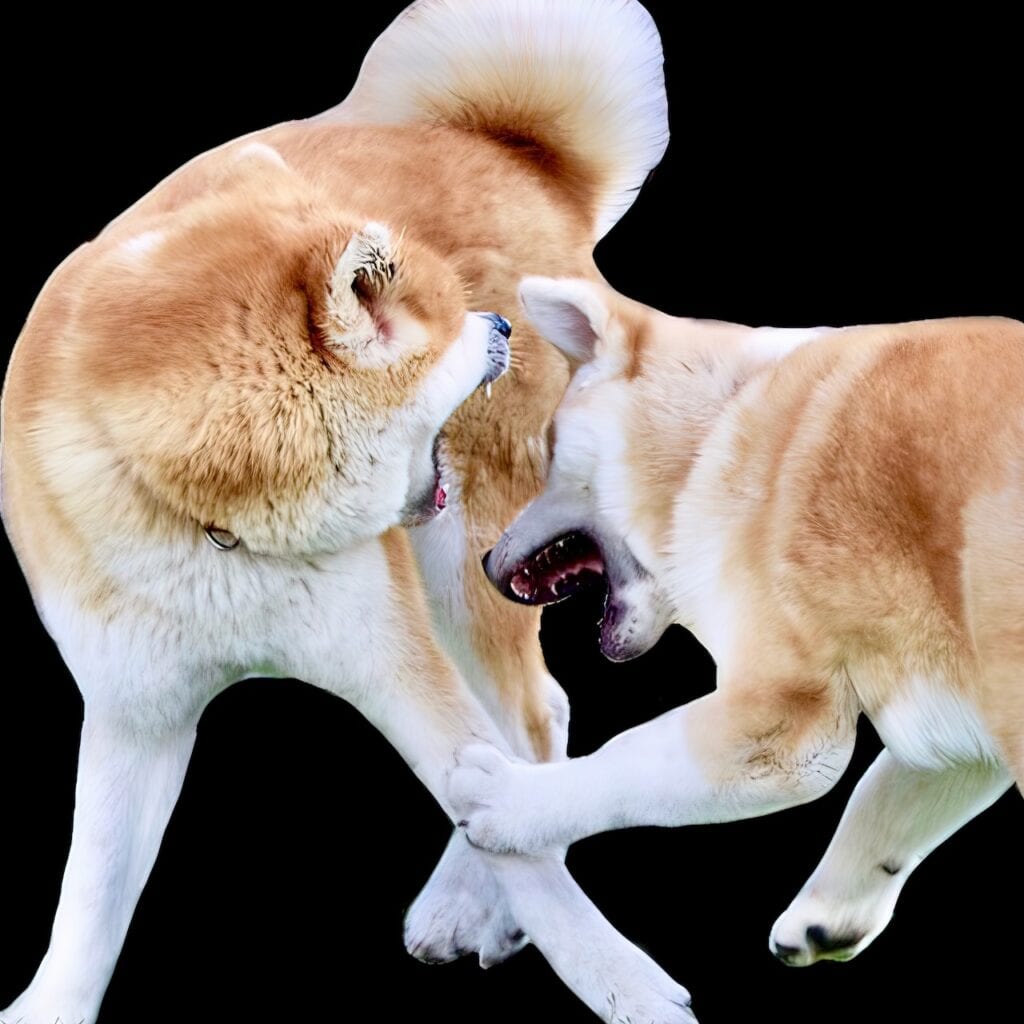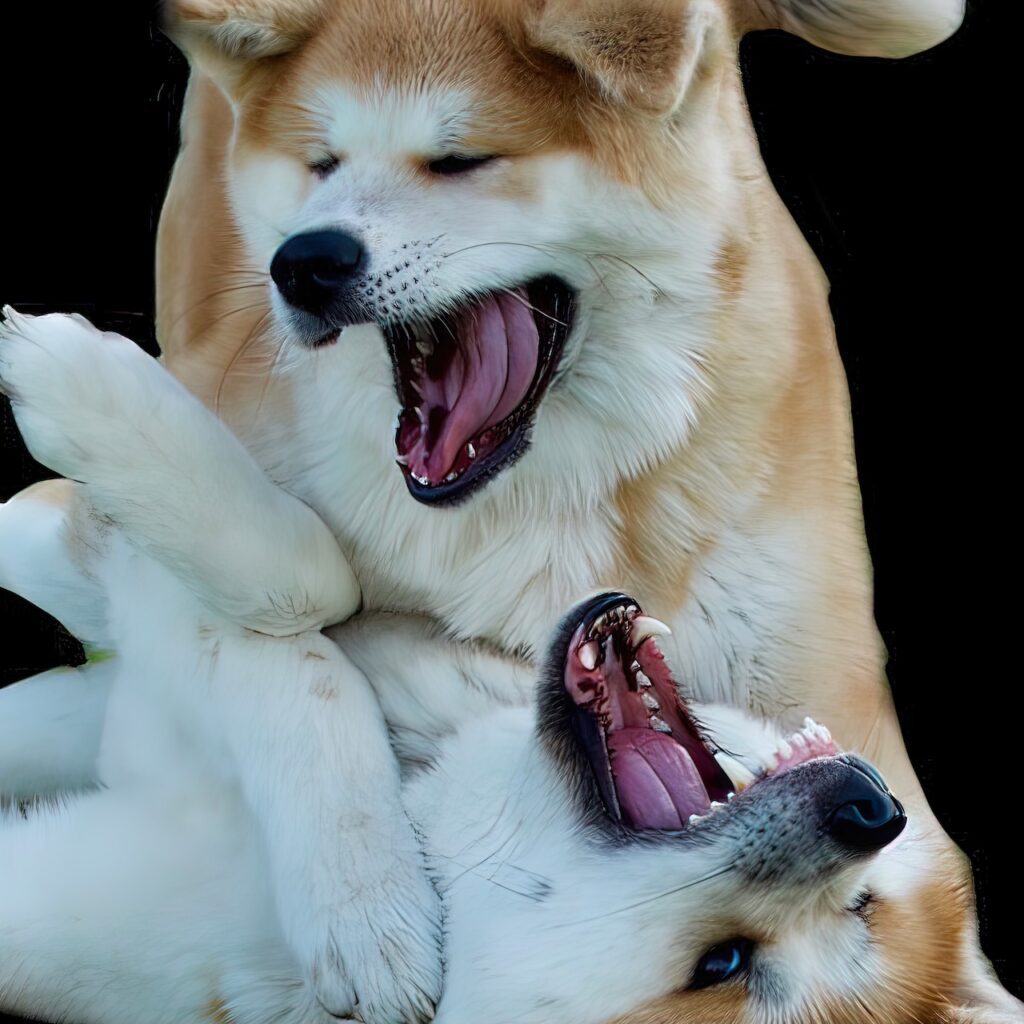The Akita Inu — Overview Of The Breed
The Akita Inu is the tamed wolf spirit of Japan. It became famous in the early 20th century, finding its way into hearts and homes of dog owners worldwide.
Akitas are a challenge to train and mold into the perfect family-loving dog. Here’s what you can expect if you take up the challenge.
The Akita Inu - 秋田犬 Tweet

No man is an island, and no dog is a pack for itself. Just like humans need to learn how to build bridges in a society, dogs need to learn how to get along with other humans and animals. Proper socialization opens dogs to the greatest number of constructive activities and relationships.
Akitas are dominant and territorial, at their best behavior when they’re the only pet in the household. They don’t tolerate pets that resemble prey, such as hamsters, and especially loathe other dogs of the same sex, including other Akitas. Though this can be overcome with proper socialization and training, there’s always going to be a remnant of this attitude in an Akita. The best remedy is to always keep an Akita in polite company and don’t allow the situation to escalate beyond control.
Akitas are cautious towards strangers and don’t take too kindly to being approached, teased or fondled without invitation. They get used to their humans but strangers beware. The Japanese royalty dealt with this by hiring a dedicated Akita keeper; today, in dog shows you will find specialist handlers who only deal with Akitas. Even in the dog show event, if an Akita isn’t used to judges, it won’t put its best paw forward.
Mr. Hatakeyama, an Akita breeder from Japan, says his number one rule for Akitas is — don’t let them miss their walks. Still, if you haven’t socialized an Akita at home, you will struggle to keep it under control when you’re out and about. Akitas have a high wanderlust potential and will take off after any scent or prey that catches their interest. This can take the owner by surprise, so wearing a waist harness is recommended. Don’t let your Akita mingle with other dogs without supervision.
From personal experience, I know that leashes barely do anything to contain an Akita that’s gone down a warpath. Even when wearing a waist harness, Bakudai can still catch me off guard and pull me somewhere unless I put my entire body’s weight to stop him. That’s just the hunter-killer nature of Akitas — they will rush headfirst into danger and fight to the death, no matter the odds. It’s an admirable trait in the wild but not so much in a civilized society.
I could tell countless stories about what it’s like to raise an Akita. When I first got Bakudai, he was just a puppy but already showed just how strongheaded he will grow up to be. In one instance, he snapped at a friendly Akita adult dog. There was no provocation or anything, Bakudai simply did it because he felt challenged by the presence of another dog and wanted to assert his dominance over a much larger dog.
When Bakudai was a few months old, I was walking him through a park when he was attacked by a rogue Rottweiler. I and the other owner managed to set them apart. Still, Bakudai would see red whenever we went back to the same spot, where he either smelt the scent of a Rottie or just had a flashback. I could see the killer instinct in his eyes, and he was dead set on finding that dog and dealing with it.
Still, I noticed Bakudai respects dogs that show their respect first. There were instances with another Rottweiler where everyone involved had a splendid afternoon, without so much as a snarl. Chatting with the owner of that Rottie showed that it was properly socialized as well, which means it makes all the difference in the world. I was aware enough of this to have me, Aimi and Bakudai trained together from the time they were a puppies.
Aimi showed similar aggression as a puppy to a German Shepherd who was meant to socialize her. Just like that, out of nowhere, Aimi snapped at him but luckily there were enough experienced handlers around to separate them without injury. I actually used my experience and knowledge from that incident with Aimi to resolve the above Bakudai’s encounter with the Rottie.
Later on, Aimi will be at the center of another incident, this time where she bit a friend of mine as I was walking her and Bakudai. The four of us met a dog on a leash, who started snapping at us and, while Bakudai remained calm, Aimi went berserk and bit my friend on the leg, which took a month to heal.

A headstrong and adamant dog, Akita needs to be socialized as soon as possible and kept in good company thereafter. It does need its personal space but shouldn’t be left alone for too long. Otherwise, it can be dangerous to strangers when its protector instincts kick in. Luckily, Akitas want to participate in whatever the family is doing, and they can enjoy mouthy activities, such as carrying toys and other items.
Through group activities and friendly interactions with strangers from the earliest age, they can be put at ease and turned into a neighborhood mascot. When behaving well, Akita is as cuddly and playful as a cat. When behaving poorly, they might treat their human family the same way they treat their toys, herding and hurting adults and kids alike.
When annoyed or disgruntled, an Akita will moan, groan, grumble and whine. It’s not possible to ignore Akita’s discontent and the owner would be ill-advised to do so anyway. Listen to your Akita and you’ll soon learn what it’s trying to tell you. You shouldn’t expect plenty of barking, though Akita is known to bark when joyous.
Every Akita will have its own behavior pain point. For one, it might be that car rides are making it sick and for another it could be nightfall that triggers whimpering due to loneliness. They have their own likes and dislikes, so learn how to work around them. Learning dog body language helps a lot in understanding when an Akita has had enough and how to prevent conflicts instead of desperately struggle to contain them.
Akita will naturally obey and follow the pack leader, so you must become one. This applies to children as well and they must learn to be assertive and command respect from Akita, who will challenge weak humans and animals alike. Folk tales relate moms leaving their babies in the custody of Akita while they run errands but it’s not as simple as that. A well-socialized Akita can be protective towards children it knows well but that’s not a given.
Akita is a reactive dog and eager to please an owner it respects but doesn’t take kindly to threats. If stared down, an Akita can see it as a challenge and lash out. Provide it with a firm but not stiff hand and you’ll get the most loyal dog imaginable. They need to bond with their human family, which they do through shared activities. You shouldn’t impose your will at all costs, but you shouldn’t be a pushover either; find a compromise that keeps everyone happy.
Akitas can be cautious and reserved but also overwhelming without even realizing it, creating enemies for life in a heartbeat. It’s an alpha dog, possessive of food and toys. They don’t like being teased or their toys, food or living space fiddled with.
An Akita isn’t clingy and can easily become defiant. Containing a fight is difficult with Akita, so do whatever you can to anticipate fights and squelch them right away. Expect your Akita to have natural guarding instincts that you should bring to heel.
I highly recommend one-to-one obedience classes with an expert trainer. You can also adopt a female Akita, since she will have slightly lower aggression levels than a male one. With two Akitas in the same household, you’ll see plenty of power struggles, though in male-female combos the male will always take the lead and dominate the relationship.
I did notice at one time that Bakudai intervened when Aimi got upset with a stranger dog and sort of indicated she should take the back seat. It was my neighbor’s dog that approached my fence and started provoking Aimi, who responded in kind. Bakudai immediately joined in and, though he wasn’t barking at first, he indicated to Aimi to walk away and then started lashing out at the neighbor’s dog.
All of this is meant to show you just how complex Akita’s behavior is. When you have only one Akita, you’re dealing with a unique personality that you can figure out, but when you have two of them, you have to account for how they treat each other. The key takeaway here is that you should know your Akita, how it acts and what to expect from it. As long as you’re proactive, remain calm and know how to minimize uncomfortable situations through training, you’ll do just fine.

Akitas tend to think before they react, but then they suddenly snap, which can make them seem impulsive and ferocious. The real Akita is somewhere in between, a careful, watchful dog that has an almost limitless potential for aggression if provoked.
When you set an Akita on guard duty, you should give it total domain of the entire property. You’ll find it a dependable, trustworthy dog that alerts to stranger presence without fail.
Adult Akitas that haven’t been socialized on time approach any kind of training with a “what’s in it for me” attitude. You should use structured games, activities and rewards to bend them to your will because there’s simply nothing else that works. Otherwise, you run the risk of the Akita quickly getting bored and indifferent.
If not socialized on time, Akitas may develop anxiety, aggressiveness or depression. Akita does display a shrewd mind, with independent thought and a capability for reasoning. Find simple, repeatable lessons and use plenty of positive reinforcement. The lessons shouldn’t be too long or too complicated. The goal is for the Akita to become a confident, pleasant and well-rounded dog.

Akita is more than just a squinty furball with a coiled tail. It has psychological and emotional needs too, which are normally handled by the rest of their dog family. Other dogs instinctively know when and why another dog from their family is misbehaving but for humans that instinct has to be honed. Unless you work on honing your instincts and training your Akita, you’ll be lulling yourself into a sense of false security and your Akita’s sudden change in behavior during a crisis will shock you.
If you’ll be having Akita as the only dog in your household, you need to give it enough psychological and emotional outlets, otherwise it may grow into an insular and destructive animal. It’s not possible to treat an Akita like a common yard dog and just leave it be. You will either treat your Akita as a fully-fledged household member or you shouldn’t own an Akita in the first place. For dog owners who want two Akitas in the same household, avoid having them of the same gender and go with the male-female combo.
A proper dog breeder would start off with socialization as soon as the puppy is born. In the litter is where dogs get the chance for their first impression of humans, and how they get to experience us is what will mark their entire life. Ideally, this socialization would result in puppies that are curious, relaxed and playful around humans.
It’s only after the first month that the breeder should ramp up the socialization efforts. A responsible breeder would work with the entire litter at once, creating socialized dogs with good temperament that fit any family. That will make the transition from the litter to its new home smooth and effortless.
When the puppy is comfy in its new home, you can start working in a collar and then follow through with taking the puppy out for a walk. Don’t panic or overreact if the puppy starts rolling on the floor, spinning in circles or just scratching at the collar when you first put it on. Take it off, wait for the doggy to cool down and try again. Don’t rush anything and don’t let frustration take hold of you and your plans.
It’s common for an Akita to whimper and whine when first wearing a collar and you can expect some drama out of the whole ordeal. After the Akita pup is comfortable with wearing the collar and doesn’t fight it, sneakily attach a leash and call the dog to you. Don’t let it loose with a leash attached, though. If your goal is for your Akita to participate in show, collar and leash training is the perfect opportunity to make it accustomed to standing still or handling itself with grace.
Akitas need to learn to be gentle, which takes a lot of time, effort and patience at the earliest stage of their development. Today, it’s hard to dedicate the time to properly socialize a dog and most people just give up on it. That means Akita is not recommended for first-time dog owners.
Be gentle and patient with your Akita and don’t lose your temper. People who get frustrated with their dogs most often yell at them, not realizing the dog can’t understand a word they’re saying but can feel the underlying emotions. Don’t pummel your Akita with negative emotions, no matter how frustrated you get, and just keep working on socialization. Use reassurance and rewards to mold your Akita into a pleasurable, laid-back dog and you’ll be rewarded with a playful, kind and gentle angel in a dog costume.
The Akita Inu is the tamed wolf spirit of Japan. It became famous in the early 20th century, finding its way into hearts and homes of dog owners worldwide.
Akita Inu has a checkered history filled with drama and struggle. Only in the latter half of the 20th century the breed got the recognition it deserves.
The iconic Akita dog is first recognized by its curled-up tail, pointed ears and fluffy fur. It has an imposing size but also a noble, calm demeanor that can still quickly turn sour if it’s agitated. It’s one of the most impressive dog breeds, carrying in itself the spirit of ancient Japan.
Akitas are a challenge to train and mold into the perfect family-loving dog. Here’s what you can expect if you take up the challenge.
Training an Akita is a learning experience for its owner and the dog itself. It starts off with housebreaking and continues with fun daily exercises.
Hormones regulate every body function, from growth to reproduction. This article describes some common Akita hormone issues, including diabetes and Addison’s disease.
Akitas are low-maintenance dogs when it comes to grooming but are fussy about how you do it. Here are some actionable tips on how to make Akita grooming as easy as pie.
Akita’s immune system is a protective mantle against the environment. Understanding how it works helps you keep it working fine, even in Akita’s old age.
Akita’s immune system is a protective mantle against the environment. Understanding how it works helps you keep it working fine, even in Akita’s old age.
Akita’s immune system is a protective mantle against the environment. Understanding how it works helps you keep it working fine, even in Akita’s old age.
Akita eye problems always happen because of a nutritional deficiency and a congenital defect. Diet fortified with nutrients and early eye exams are the simplest way to detect and manage eye problems in Akita
Akitas might not like to mingle but they can still catch communicable diseases just like any dog breed that does. These diseases quickly spread through a litter, especially an unvaccinated one, even without physical contact; all it takes is an infected bowl, toy, or blanket to spread the disease.
A limping Akita is a sad sight to behold. It seems to need help but suddenly the limp disappears and the Akita acts fine. This is a warning sign that trouble is afoot and the Akita is about to develop an issue with its joints, spine or both. Here is an overview of joint and spine problems in Akita, with probable causes and suggested remedies.
Training an Akita is a learning experience for its owner and the dog itself. It starts off with housebreaking and continues with fun daily exercises.
Spirits are all around us and some of them take unusual forms. One of them is – Akita. We feel affection washing over us, turn around and see its friendly smiling face and a wagging tail.
All the best adventures start with a simple walk and end up in exhilaration. Join me on Akita’s forest walk to see how a natural hunter stays fit in the wild.
Climbing to the top requires the sheer power of will to push against inertia. Those that do succeed can marvel in a breathtaking view of how far they’ve gone.
Tame senses become awakened when entering an ancient winter forest. The primal yearning to experience the environment becomes manifest in a snow-clad forest.
All the best adventures start with a simple walk and end up in exhilaration. Join me on Akita’s forest walk to see how a natural hunter stays fit in the wild.
Get notified about new articles